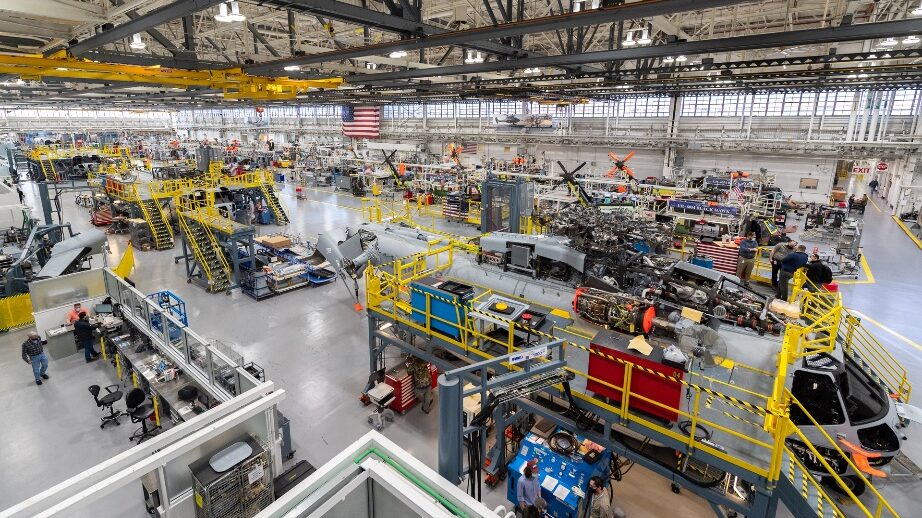
The CH-53K production line in Sikorsky’s facility in Stratford, Conn. (Courtesy of Lockheed Martin Sikorsky)
STRATFORD, Conn.: Automated tools. Additive manufacturing. Augmented reality. 3D printing.
Sikorsky’s production lines for several helicopters at its Stratford, Conn., facility feature all these capabilities, which company executives say give them a competitive advantage in their tense competition with Bell Textron to build the next generation of the Army’s helicopters, the Future Attack Reconnaissance Aircraft and the Future Long Range Assault Aircraft.
“We are implementing this today on the production line,” Sikorsky President Paul Lemmo told reporters last week during a tour of the facility.
Sikorsky hosted the reporters in an effort to highlight the advanced tools the company already uses on its manufacturing floor to make UH-60 Black Hawks and the new CH-53K, which recently achieved initial operational capability status. The tour of Sikorsky’s facility came weeks after Bell invited reporters in March to their facilities in Texas to showcase a slew of advanced manufacturing it plans to install in its future factories. The not-so-subtle point: Sikorsky says they already use advanced techniques.
RELATED: ‘A recipe for the parts’: Bell plans factory of the future with FARA, FLRAA dreams
The CH-53K is the company’s newest version of the Marines’ heavy-lift helicopter. For this version, Sikorsky built what company officials called a “digital thread” rendering for the helicopter that ensures machines and workers are referencing the same plans from the initial design to production to sustainment. Sikorsky officials said they believe that already using the digital thread method on a current production line gives them a competitive advantage for the Army future vertical lift competition.
“We’re pretty much wrapped up with development on 53K, we’re in production going to full rate, and we’re already starting efforts to sustain the aircraft out in the fleet. We’re proving out that digital thread and all the tools that go with it,” Lemmo said. “I think we’re well down that path. Now, we’re certainly looking to take it to the next level with FVL… We feel like because we put it in practice, we will be able to execute FVL much more efficiently.”
During a tour of the facility, reporters saw automated tools, augmented reality, three-dimensional work instructions, automated part inspection, 3D printing of rotorcraft parts, simulators and modeling using supercomputers. (Breaking Defense, like other publications, accepted travel accommodations from Sikorsky for this tour and from Bell previously.)
“We don’t need a lot of new investment for future vertical lift programs,” Lemmo said. “You know, it’s pretty much in the factory today or coming in the next year or so.”
Lemmo said that the new technologies that parent company Lockheed Martin had invested in have reduced production timelines and reduced costs.
Sikorsky also has invested in additive manufacturing capabilities, including 18 thermoplastic 3D printers. Bob Perchard, director of manufacturing engineering at Sikorsky, said the facility would receive two metal 3D printers by the end of the year.
Perchard said “hundreds” of parts on FARA and FLRAA would be 3D printed, including drive system and rotor system components.
As for CH-53K, the Stratford plant will produce four aircraft this year, eight in 2023 and 16 in 2024. Sikorsky expects a full-rate production decision in 2023.
Amid Ukraine Conflict, Potential Black Hawk Opportunities In Eastern Europe
Sikorsky’s 5,000th UH-60 Black Hawk will reach the production line in Stratford this year as the Army plans to end procurement of the storied helicopter in fiscal 2028, in favor of the FLRAA rotorcraft.
Production for FLRAA wouldn’t ramp up until the early 2030s, however. But with no production contract for Black Hawks during that time, Sikorsky would look to fill the gap with Black Hawk modernization in coming decades and through foreign military sales, Lemmo said.
“Black Hawk is still very ubiquitous and in demand around the world,” he said.
Another potential factor in the future of the Black Hawk program is Russia’s invasion of Ukraine, which may present potential sales opportunities for the helicopter.
“It’ll be interesting to see, you know, in Eastern Europe, given many of them fly Russian helicopters — they’re probably not gonna get parts for those,” Lemmo said. “Are they going to look to the West as those fleets get depleted? We certainly would like to offer the Black Hawk as a potential solution there.”






















